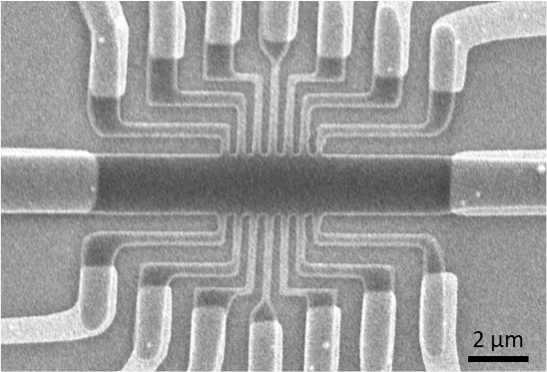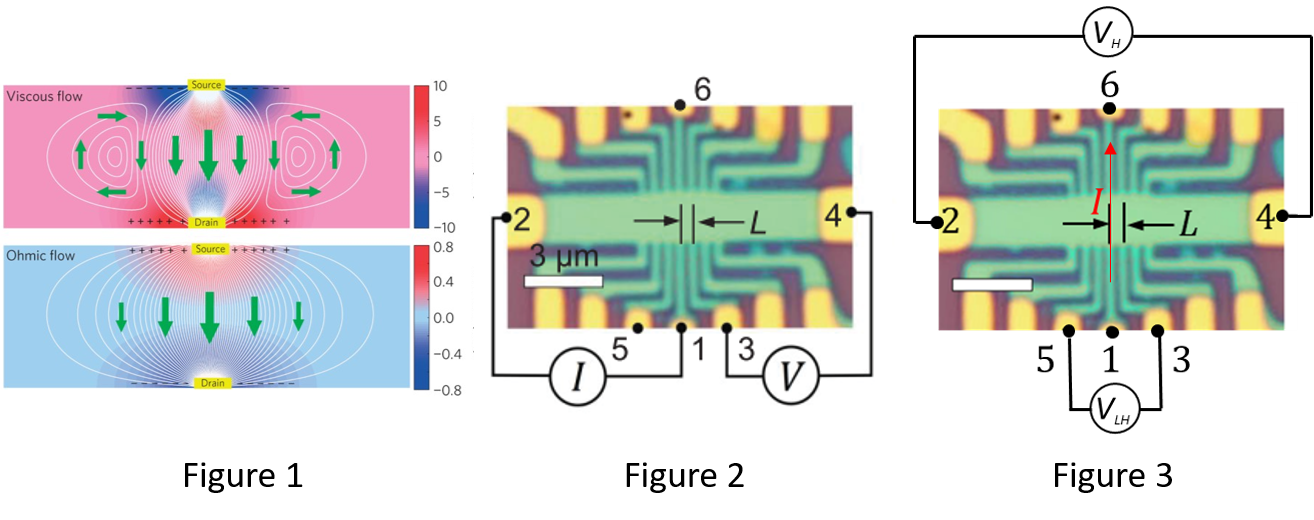
When e-e collisions dominate over other scattering mechanisms, such as impurities and phonons, the electronic transport resembles a classical fluid flow. The weak electron-phonon interaction and high mobility in graphene make it be an idea system to study electron fluid. Recently, such electron hydrodynamics has been evidenced by several experiments [1-5]. One of them is the formation of submicrometer-size whirlpools near current injected contacts [6], as shown in Figure 1. The above SEM of vicinity geometry graphene device shows the way to detect such local whirlpools. The electrode probes are separated by 0.5 μm, fabricated by highly precise e-beam lithography and dry etching. The electronic whirlpool flow is evidenced by the negative voltage drop in vicinity geometry, as shown in Figure 2. Under time-reversal symmetry breaking by applying a small magnetic field, the measurements of vicinity resistance help us observe viscous hall effect arising from the contribution of Hall viscosity [7]. Moreover, our device design also allows us to measure the local Hall resistance as shown in Figure 3. Compared with ordinary Hall effect, the local Hall resistance is notably suppressed when the system goes into hydrodynamic regime, another observable result caused by hall viscosity [7].

References:
[1]. D. A. Bandurin, et. al., “Negative local resistance caused by viscous electron backflow in graphene”, Science, 351(6277), 1055-1058, (2016).
[2]. Krishna Kumar, et. al., “Superballistic flow of viscous electron fluid through graphene constrictions”, Nature Physics, 13, 1182-1185, (2017).
[3]. J. Crossno, et. al., “Observation of the Dirac fluid and the breakdown of the Wiedemann-Franz law in graphene”, Science, 351(6277), 1058-1061, (2016).
[4]. J. Sulpizio, et. al., “Visualizing Poiseuille flow of hydrodynamic electrons”, Nature, 576, 75-79, (2019).
[5]. M. J. H. Ku, et. al., “Imaging viscous flow of the Dirac fluid in graphene”, Nature, 583, 537-541 (2020).
[6]. L. Levitov, et. al., “Electron viscosity, current vortices and negative nonlocal resistance in graphene”, Nature Physics, 12, 672-676, (2016).
[7]. A. I. Berdyugin, et. al., “Measuring Hall viscosity of graphene’s electron fluid”, Science, 364(6436), 162-165, (2019).